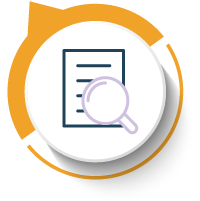Learning Objectives
By the end of this topic, the student should be able to:
- Discuss how opioid use can result in opioid use disorder.
- Compare and contrast the two common opioid agonist therapies: buprenorphine and methadone.
- Explain the role of naltrexone in opioid use disorder.
- Describe the pharmacological agents used to treat opioid withdrawal symptoms.
- Identify non-pharmacological treatments and their role in opioid agonist therapy (OAT).
- Identify emerging opioid agonist and other therapies for opioid use disorder.
Key Concepts
- Opioid use disorder is diagnosed based on the DSM-5. Harmful or problematic opioid use may occur with or without a formal diagnosis and involve prescription opioids, unregulated opioids, or both.
- The main pharmacotherapy for problematic opioid use is opioid agonist therapy (OAT). Buprenorphine or methadone are the two most common pharmacotherapies.
- The opioid antagonist, naltrexone, is used to reduce cravings for opioids. Other non-OAT pharmacotherapies also show promise in opioid use disorder. Long-term implants and related dosage forms are also being developed for opioid and non-opioid therapies.
- For many patients, symptoms of withdrawal may occur before initiation of opioid agonist therapy. Additional pharmacotherapies for withdrawal management include both prescription and over-the-counter drugs.
- Although OAT can be used without additional interventions, it is often coupled with non-pharmacological treatments, including individual and group therapy and other psychosocial supports.
- In addition to existing OAT (buprenorphine and methadone) other opioid replacement pilot projects, as treatment or as harm reduction, include hydromorphone, fentanyl, and diacetylmorphine (heroin).
Opioid Use Disorder
Experiencing tolerance, dependence, or withdrawal on their own does not mean a person has opioid use disorder. The Diagnostic and Statistical Manual of Mental Disorders (DSM) diagnosis can be mild (two to three symptoms), moderate (four to five symptoms), or severe (six or more symptoms).
A diagnosis of opioid use disorder is described in the DSM-5 (American Psychiatric Association, 2013).
DSM-5 Diagnostic Criteria for Opioid Use Disorder
Two of the following must be observed within a 12-month period:
- Opioids are often taken in larger amounts or over a longer period than was intended.
- There is a persistent desire or unsuccessful efforts to cut down or control opioid use.
- A great deal of time is spent in activities necessary to obtain the opioid, use the opioid, or recover from its effects.
- Craving, or a strong desire or urge to use opioids is present.
- Recurrent opioid use results in a failure to fulfill major role obligations at work, school, or home.
- Opioid use continues despite having persistent or recurrent social or interpersonal problems caused or exacerbated by the effects of opioids.
- Important social, occupational, or recreational activities are given up or reduced because of opioid use.
- Recurrent opioid use occurs in situations in which it is physically hazardous.
- Opioid use continues despite knowledge of having a persistent or recurrent physical or psychological problem that is likely to have been caused or exacerbated by the substance.
- The person exhibits tolerance.
- The person exhibits withdrawal, including self-medication to manage withdrawal.
For clients using prescription opioids, screening tools such as the Prescription Opioid Misuse Index (POMI) may be employed by physicians or health and social service professionals.
On a societal level, opioid use or opioid use disorder can increase the following:
- marginalization and loss of social cohesion
- family break down
- absenteeism from school and work
- criminal activity
Treatment of Opioid Use Disorder - OAT
Opioid agonist therapy or treatment (OAT) is the primary treatment for opioid use disorder or problematic opioid use.
- The goals of therapy include replacing problematic opioid use with regular use of specific opioids and doses, prescribed by a physician, and avoiding symptoms of withdrawal.
Compounds Used for OAT
Methadone
Methadone is a full agonist at the opioid receptor, and a longer-acting opioid.
Buprenorphine
Buprenorphine is a partial agonist at the opioid receptor meaning that it activates the receptor, but not maximally. Thus, in the presence of a full agonist, it actually acts as an opioid receptor blocker, and can even induce opioid withdrawal symptoms.
- The most commonly used buprenorphine is formulation in a sublingual tablet mixed with naloxone called Suboxone to prevent injection of the product. If it were to be injected, the naloxone would block the effects of buprenorphine. But because naloxone is not well absorbed orally, when taken as directed, it does not interfere.
- Buprenorphine long-acting subcutaneous injection (Sublocade) can also be used in adults already on stable dose of buprenorphine-naloxone
Methadone Versus Buprenorphine
See Module 1 Topic K for considerations about choosing an OAT.
Effectiveness
- Both methadone and buprenorphine are effective therapies.
- Methadone does better by some measures in clinical trials.
- 73 percent retention in treatment versus 22 percent given placebo, compared to buprenorphine/naloxone, which had 64 percent retention in treatment versus 39 percent given placebo.
Initiation
- Initiation of buprenorphine treatment requires patients to be in withdrawal for at least 12–24 hours. Methadone can be started immediately.
- Many provinces and territories have prescribing restrictions for methadone, and prescribers require an exemption to prescribe it.
Administration
- buprenorphine-naloxone is placed under the tongue for 10 minutes to absorb the buprenorphine sublingually; buprenorphine long-acting is given subcutaneously on a monthly basis.
- Methadone is given as a liquid formulation, and dosing is often observed by a pharmacist.

- OAT dispensing is complex, and specific rules and regulations vary provincially and territorially (for example, see these documents from Alberta and Ontario).
- Although OAT can be tapered to reduce or cease opioid use, OAT is often long-term and there is no maximal duration of therapy.
- Patient contracts, treatment agreements, and urine drug screening may be mandated by the prescriber, or in some cases, by provincial and territorial regulations.
Withdrawal Management
In addition to OAT, which can be initiated immediately (methadone) or 12–24 hours after withdrawal symptoms (buprenorphine), additional pharmaceutical agents are used to manage the symptoms of opioid withdrawal:
- clonidine, an alpha2-adrenergic receptor agonist, for anxiety
- quetiapine, an atypical antipsychotic, for anxiety
- trazodone, an antidepressant and antihistamine, for sleep
- ibuprofen, a cyclo-oxygenase inhibitor, for pain
- dimenhydrinate, an antihistamine, for nausea
- ondansetron, a serotonin blocker, for nausea
- loperamide, a peripheral opioid, for diarrhea
In addition to the agents listed above, other drugs may also be used to treat specific withdrawal symptoms.
Non-Pharmacological Treatment
In addition to OAT, therapy and psychosocial supports are key components of opioid use disorder treatment. Several studies, including clinical trials, initially failed to detect significant benefits for psychosocial supports and interventions for OAT patients, including the efficacy of residential treatment.
Although OAT can be effective on its own, recent findings suggest counselling can increase the retention in treatment from 62 percent to 74 percent of patients on OAT (Amato et al. 2013).
NOTE: Although health and social service providers should be guided by the medical evidence, each substance use story is unique, and there are many individual success stories that may not match, or may even contradict, the current evidence-based conclusions.
Additional Opioid Agonist Therapies
In addition to methadone and buprenorphine-naloxone, other opioid therapies have been evaluated or are being piloted.
- Slow-release oral morphine is often prescribed by an addiction specialist or a prescriber authorized to prescribe methadone.
- In addition to oral dosage forms, there is interest in using injectable opioids, particularly for persons who may have contraindications or have not experienced efficacy with established oral therapies.
- Prescription injectable diacetylmorphine, or heroin, has been used in several jurisdictions and evaluated in clinical trials.
- A meta-analysis in 2015 found that this treatment was effective at reducing the use of unregulated opioids, even in some cases compared to control groups taking established OAT (Strang et al., 2015).
- Safety concerns, including respiratory depression and concerns about diversion, required more attention by prescribers and other health care practitioners (Strang et al., 2015).

- Injectable hydromorphone has also been evaluated, including a recent trial in Vancouver, and was shown to be as effective as other injection OAT with respect to retention in treatment (Bell et al., 2018, Oviedo-Joekes et al., 2019).
In theory, any opioid, administered orally or via injection, has the potential to be effective as a replacement for unregulated opioid use. What’s needed is a better understanding of which individuals are likely to do best with which type of opioid agonist therapy.
Additional and Other Emerging Therapies
In addition to OAT, pharmaceutical agents may be beneficial in maintaining abstinence in patients diagnosed with opioid use disorder who have stopped using opioids.
Naltrexone is an opioid receptor antagonist, like naloxone, that has shown promise to maintain opioid abstinence.
- Unlike naloxone, naltrexone can be administered orally and is longer acting
- It has also been developed into extended-release, very long acting (up to three months) formulations.
- Naltrexone is also used to reduce alcohol intake or maintain alcohol abstinence.
There is also interest in evaluating psychedelic drugs in both medical and non-medical (i.e., traditional) settings.
- Associations between the availability of medical or recreational cannabis and positive indicators related to opioid use has led to interest in specific cannabinoids, such as cannabidiol (CBD), on opioid use and addiction.